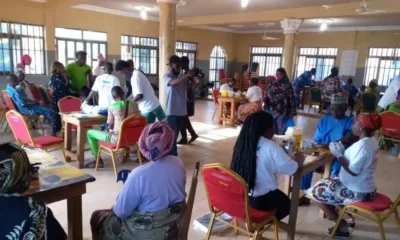News
Breaking: WHO Announces Deadly Tropical Disease That Could Cause Frequent Death…

The World Health Organisation (WHO) has announced profiling of another deadly tropical disease that could destroy facial tissues and bones and frequently lead to death.
The global health agency identifies the tropical disease as Noma (cancrum oris or gangrenous stomatitis), describing it as one of the world’s most under-recognised health challenges.
The pictures are horrible, The Eagle may not be able to show it,
but the WHO has also just included it in its official list of neglected tropical diseases (NTDs), following a recommendation by the 17th meeting of its Strategic and Technical Advisory Group for Neglected Tropical Diseases (STAG-NTD).
A severe gangrenous disease of the mouth and face, Noma, is deadly tropical disease that primarily affects malnourished young children, between the ages of 2 and 6 years, in regions of extreme poverty.
This makes Sub-Saharan Africa, a most vulnerable region for the disease.
The Eagle reports the World Bank data indicating that about 462 million people in the region are still living in extreme poverty in 2023.
READ ALSO: How Neglected Tropical Diseases Afflicted 167k Nigerians in..
Mentioning climate-related issues, the COVID-19 pandemic, and mounting conflicts as factors, the bank, said SSA continues to grapple with high debt distress risks, with 21 countries identified as either at high risk of external debt distress or already ensnared in it as of June 2023.
On the other hand, the new deadly tropical disease, according to a release by the WHO, starts as an inflammation of the gums, which, if not treated early, spreads quickly to destroy facial tissues and bones, frequently leading to death.
Those who survive the attack, suffer severe disfigurement, the agency says.
“Accurate estimation of the number of noma cases is challenging due to the rapid progression of the disease and the associated stigma, which contributes to leaving many cases undiagnosed.
“Cases of noma are mostly found in sub-Saharan Africa, although cases have also been reported in the Americas and Asia.
“Evidence indicates that noma is caused by bacteria found in the mouth. There are multiple risk factors associated with this disease, including poor oral hygiene, malnutrition, weakened immune systems, infections, and extreme poverty. Noma isn’t contagious but tends to strike when the body’s defenses are down”, the WHO informs.
According to it, early detection could be decisive in managing the ailment, given that therapy is most effective at the early stages of disease when it causes severe swollen gums, known as acute necrotizing gingivitis.
READ ALSO: Indiscriminate Artificial Insemination: Animal Reproduction Experts React
“Treatment involves antibiotics, advice and support on practices to improve oral hygiene with disinfectant mouthwash (salt water or chlorhexidine could be used) and nutritional supplements.
“If diagnosed during the early stages of the disease, treatment can lead to proper wound healing without long-term consequences. In severe cases though, surgery may be necessary”.
It says children who survive the gangrenous stage of this deadly tropical disease, are likely to suffer severe facial disfigurement, have difficulty eating and speaking, face social stigma and isolation, and need reconstructive surgery.



















